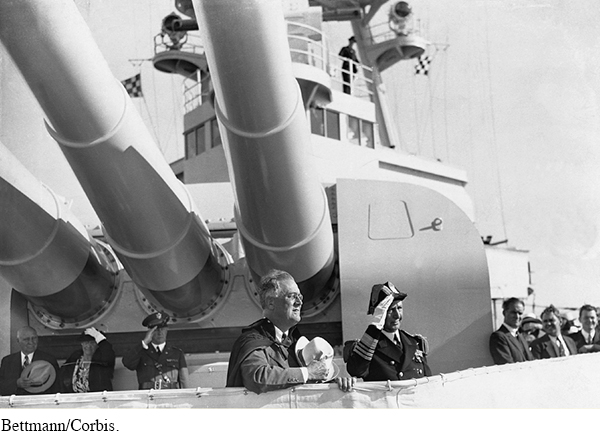Making Historical Arguments: How Did the New Deal Contribute to National Defense?
How Did the New Deal Contribute to National Defense?
The New Deal strengthened the nation by providing relief and employment. In the 1930s, most New Dealers and most Americans believed the biggest threats to the nation were domestic poverty and unemployment, not foreign nations. In contrast, Germany, Japan, and the Soviet Union aggressively built up their military might during this period. Germany, for example, multplied its military spending by a factor of thirty-
Americans’ complacency about foreign threats worried military planners, who believed that Japan in particular posed a dangerous military challenge to American interests. During the 1930s, Japanese military spending multiplied by nine, with the vast majority before 1937 going to the Japanese navy; the Japanese army got a larger share after 1937 when military conquests in Asia required more soldiers. According to American military planners, the U.S. Navy — not the army — needed to be rebuilt and modernized to counter the threat from Japan.
After World War I, the United States drastically shrank its military. By 1930, American armed forces numbered about 230,000 soldiers and sailors, less than half the size of Italy’s military, even though the U.S. population was three times larger than Italy’s. International treaties signed after World War I limited the size of the navies of the major powers to prevent a naval arms race that might lead to war. Both German and Japanese navies exceeded their treaty limits, but during the 1920s the U.S. fleet numbered only about 75 percent of the ships permitted by treaty. Congress and Republican presidents during the 1920s had no desire to build expensive warships, especially after the Great Depression struck. Most Americans agreed, sharing the view of a British leader in 1931 that “war was never more remote, nor peace more secure.”
Unlike his predecessors, President Roosevelt had long advocated naval power, a view strengthened by his service as assistant secretary of the navy during the Wilson administration. Soon after his election, a battleship captain privately wrote Roosevelt, “Take good care of Uncle Sam’s Navy! We have long been in need of a friend . . . in the White House.” Lacking congressional support for rebuilding the fleet, Roosevelt and his advisers attached a provision for building thirty-
Secretary of Labor Frances Perkins explained that “the Navy is part of the public works project, and the purpose of the [NIRA] is not to build ships but to give employment.” When many more millions were earmarked from Public Works Administration (PWA) funds for naval aircraft and renovation of shore stations, Harold Ickes, the head of the PWA, fumed, “I hate to see $70 million go into one battleship when we are having difficulty keeping our people from starving.” Roosevelt’s supporters — who included the navy, private shipyards, and congressional advocates of naval power — argued that PWA funds were better spent to “get some kind of decent Navy than . . . to rake leaves.” However, Ickes and other critics continued to denounce Roosevelt’s sweetheart deal with the navy. “The Navy has more Public Works money tied up than any one else,” Ickes thundered, adding, “There isn’t enough money in the United States Treasury to satisfy the Navy.”
Naval rearmament masquerading as public works was only the beginning of New Deal support for naval shipbuilding. In March 1934, Roosevelt signed the Vinson-

Questions for Analysis
Summarize the Argument: How did the New Deal contribute to national defense?
Analyze the Evidence: What New Deal measures authorized naval rearmament? How did critics respond to these measures?
Consider the Context: How did New Deal domestic programs influence naval rearmament?